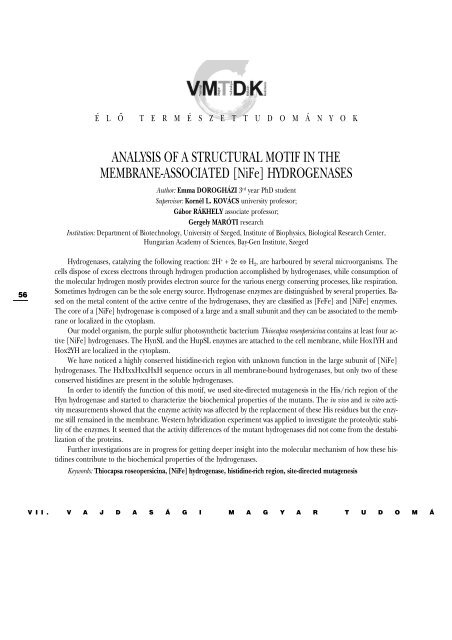Rezümékötet 2008. - vmtdk
Rezümékötet 2008. - vmtdk
Rezümékötet 2008. - vmtdk
Create successful ePaper yourself
Turn your PDF publications into a flip-book with our unique Google optimized e-Paper software.
56<br />
É L Õ T E R M É S Z E T T U D O M Á N Y O K<br />
ANALYSIS OF A STRUCTURAL MOTIF IN THE<br />
MEMBRANE-ASSOCIATED [NiFe] HYDROGENASES<br />
Author: Emma DOROGHÁZI 3 rd year PhD student<br />
Supervisor: Kornél L. KOVÁCS university professor;<br />
Gábor RÁKHELY associate professor;<br />
Gergely MARÓTI research<br />
Institution: Department of Biotechnology, University of Szeged, Institute of Biophysics, Biological Research Center,<br />
Hungarian Academy of Sciences, Bay-Gen Institute, Szeged<br />
Hydrogenases, catalyzing the following reaction: 2H + + 2e ⇔ H 2, are harboured by several microorganisms. The<br />
cells dispose of excess electrons through hydrogen production accomplished by hydrogenases, while consumption of<br />
the molecular hydrogen mostly provides electron source for the various energy conserving processes, like respiration.<br />
Sometimes hydrogen can be the sole energy source. Hydrogenase enzymes are distinguished by several properties. Based<br />
on the metal content of the active centre of the hydrogenases, they are classified as [FeFe] and [NiFe] enzymes.<br />
The core of a [NiFe] hydrogenase is composed of a large and a small subunit and they can be associated to the membrane<br />
or localized in the cytoplasm.<br />
Our model organism, the purple sulfur photosynthetic bacterium Thiocapsa roseopersicina contains at least four active<br />
[NiFe] hydrogenases. The HynSL and the HupSL enzymes are attached to the cell membrane, while Hox1YH and<br />
Hox2YH are localized in the cytoplasm.<br />
We have noticed a highly conserved histidine-rich region with unknown function in the large subunit of [NiFe]<br />
hydrogenases. The HxHxxHxxHxH sequence occurs in all membrane-bound hydrogenases, but only two of these<br />
conserved histidines are present in the soluble hydrogenases.<br />
In order to identify the function of this motif, we used site-directed mutagenesis in the His/rich region of the<br />
Hyn hydrogenase and started to characterize the biochemical properties of the mutants. The in vivo and in vitro activity<br />
measurements showed that the enzyme activity was affected by the replacement of these His residues but the enzyme<br />
still remained in the membrane. Western hybridization experiment was applied to investigate the proteolytic stability<br />
of the enzymes. It seemed that the activity differences of the mutant hydrogenases did not come from the destabilization<br />
of the proteins.<br />
Further investigations are in progress for getting deeper insight into the molecular mechanism of how these histidines<br />
contribute to the biochemical properties of the hydrogenases.<br />
Keywords: Thiocapsa roseopersicina, [NiFe] hydrogenase, histidine-rich region, site-directed mutagenesis<br />
V I I . V A J D A S Á G I M A G Y A R T U D O M Á




